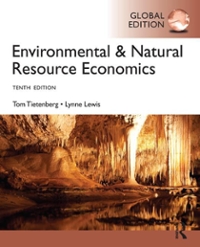Kindly provide elaborate solutions.
Question 1
1.) Suppose that we have a standard two period endowment economy with no uncertainty. The representative household receives period utility U(Ct) from consuming the basket of goods Ct where U.(Ct) > 0 and Uce(Ct) 0, then we have that MRTe, = (1+ R)MRS., in equilibrium, resulting in too much leisure and too little consumption for the household compared to the efficient allocation. Assume that the nominal interest rate is about 6% per year (4% real interest rate at 2% inflation), and that the relevant period length for the cash-in-advance constraint is a month, resulting in a period interest rate of R=0.5%.We project unit sales for a new household laser-guided cockroach search and destroy system as follows: Year 1 2 3 4 5 Unit Sales 53,000 65,000 76,000 86,000 46,000 The new system will be priced to sell at $95 each. The cockroach eradicator project will require $585,000 in net working capital to start, and total net working capital will rise to 30% of sales. The net working capital will be zero at the end of the project. The variable cost per unit is $60, and total fixed costs are $25,000 per year. The equipment necessary to begin production will cost a total of $6.5 million. This equipment is mostly industrial machinery and thus qualifies for CCA at a rate of 20%, In five years, this equipment will actually be worth about 30% of its cost. The relevant tax rate is 40%, and the required return is 20%. Based on these preliminary estimates, what is the NPV of the project?(b) (2 points) The government collects a flat rate labor income tax with a tax rate, T =10%. If the tax revenue is not enough to cover the government spending the government will borrow abroad. If the tax revenue is more than government needs, the government lends out to foreigners. What is the representative household's optimal time allocation under this flat rate tax regime? How much is consumed and how much is produced? Calculate the welfare of the representative household in this case. (c) (1 point) In the previous question does the government need to borrow or lend abroad? If so, how much? In this case is it still true that c + g = Y?Macro_homework_4_2 Solve numerically the Soiow'e model based on the following information. Equlibriurn condition are\" = :12 JKt = e{K*)%{E)i e" = e Find the equilibrium values of capital, output, investment, and consumption, 117*, 1\1. (15 points) The representative firm has a production function Y = zNV, where z is the labor productivity. The representative household has a utility function u(c, () = Ve + 18vi. Let w denote the real wage rate. (a) (2 points) Suppose that z = 200. What is the representative firm's labor demand function? What must the wage rate be at the equilibrium? At this wage rate, how much profit can this firm send to the representative household? (b) (3 points) With this wage rate and non-wage income, what are the optimal time allocation and consumption for the representative household? (c) (1 point) At the equilibrium how big is labor input and how much output is produced? (d) (3 points) Then the productivity drops. That is z = 190. At the new equilibrium how big is labor input and how much output is produced? (e) (1 points) Calculate the percentage decrease of productivity, labor input, output, and consumption. (percentage change = After Before x 100%) Is the percentage decrease in output bigger or smaller than the percentage decrease in productivity? Can you explain your finding? (f) (3 points) Anticipating the productivity drop, the government implements a stimulus package by increasing the government spending from 0 to 8. The spend- ing is financed by government borrowing, equivalent to a lump-sum tax. After implementing this stimulus package, how big are labor input and consumption? How much output is produced? (g) (1 point) Calculate the percentage change of labor input, output, and consump- tion when productivity drops but with a stimulus package. (h) (1 point) Compare your results in part (e) and (g). What do you find? 2. (5 points) The representative firm has a production function Y = 30N. Part of government spending is a perfect substitute for private consumption. Examples are Head Start and private preschool, Medicare and private health insurance, and etc. The government spending, g, enters the utility function of the representative household as the following: u(c, l; g) = In(c + 0.5g) + 2.5 In(1) Base on the above utility function, 50% of the government spending is a direct substi tute for private consumption. In this case MRS. = 2.5(c+0.5g) Suppose that the government spending g = 1. (a) (2 points) The government collects a lump-sum tax with T' = 1. What is the representative household's optimal time allocation? How much is produced and how much is consumed? Calculate the welfare of the representative household under this lump sum tax regime













